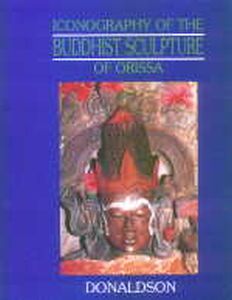
Contents: I. Text: Introduction. I. Historical background: 1. Early historical background. 2. Uddiyana-pitha. 3. Later historical background. II. Buddhist sites in Orissa: 1. Balasore district. 2. Bolangir district. 3. Cuttack district. 4. Dhenkanal district. 5. Ganjam district. 6. Keonjhar district. 7. Mayurbhanja district. 8. Phulbani district. 9. Puri district. 10. Sambalpur district. III. Buddha/Tathagata images: 1. Images of standing Buddha. 2. Images of seated Buddha. 3. Vajrasattva/Vajradhara. 4. Maitreya. IV. Mandalas and mandala Bodhisattvas: 1. Stupa mandalas with eight/sixteen Bodhisattvas. 2. Sculptural mandalas with eight Bodhisattvas. 3. Mandalas with eight free-standing Bodhisattvas. 4. Mandala Bodhisattva iconography. 5. The cult of eight Bodhisattvas. V. Manjusri images: 1. 2-Armed images with a book. 2. Seated Manjusri in a relaxed pose/Maharajalila Manjusri. 3. Seated Manjusri in Dharmacakra-mudra/Manjuvara/Manjughosa. 4. Seated Manjusri with book and sword/Arapacana/Vajratiksna. 5. Seated Manjusri in Dhyana-mudra/Vajraraga/Amitabha/Dharmasankha. 6. 2-Armed Manjusri with bow and arrow/Vajraraga (Mara). 7. 6-Armed Manjusri with bow and arrow/Manjuvajra. 8. 8-Armed Manjusri with bow and arrow/Dharmadhatu-Vagisvara. VI. Avalokitesvara images: 1. 2-Armed Avalokitesvara in Varada-mudra/Lokanatha or Lokesvara. 2. 2-Armed pensive Bodhisattva/Cintamanicakra Avalokitesvara. 3. 2-Armed Khasarpana Lokesvara. 4. 2-Armed Avalokitesvara in Dharmacakra-mudra. 5. Rakta-Lokesvara/Vajradharma. 6. 4-Armed Sadaksari Lokesvara. 7. 4-Armed Avalokitesvara/Jata-mukuta Lokesvara/Mahakaruna. 8. 4-Armed Avalokitesvara with a Conch/Sankhanatha Lokesvara. 9. 4- Armed Avalokitesvara with a noose/Amoghapasa Lokesvara. 10. 4- Armed Avalokitesvara with a Trident/Sugatisandarsana Lokesvara. 11. 6- Armed Avalokitesvara with a Trident/Sugatisandarsana Lokesvara. 12. 6- Armed Avalokitesvara with a Consort/Halahala Lokesvara. VIII. Vajrapani, male emanations of Aksobhya, and Mahakala: 1. Vajrapani. 2. Male emanations of Aksobhya. 3. Mahakala. VIII. Tara images: 1. Astamahabhaya Tara. 2. 2-Armed images of Tara. 3. 4- Armed images/Dhanada-Tara. 4. 4-Armed images/Sita-Tara. 5. 4- Armed images/Durgottarini-Tara. 6. 6- Armed images. 7. 8- Armed images/Vajra-Tara. IX. Female manifestations and emanations: 1. Female companions and the formative stage of Prajna development. 2. Goddesses of knowledge and teaching. 3. Bhrkuti. 4. Unidentified seated Goddesses. 5. Goddesses seated above/trampling upon corpses or Hindu deities. 6. Marici. X. Fertility deities, companion deities and pedestal decoration: 1. Jambhala/Pancika. 2. Hariti. 3. Vasudhara. 4. Companion deities. 5. Pedestal decoration. XI. Stylistic analysis, Brahmanical parallels and religious syncretism/animosity: 1. Architectural features. 2. Sculptural features. 3. Brahmanical parallels, composite deities and pan-Indian concepts. 4. Religious syncretism. 5. Sectarian bias: adopted deities in a subordinate role. 6. Sectarian animosity and humiliation. 7. Erotic motifs. Glossary. Bibliography. Photographic index. General index. Vol. II. Plates.
"The present book on the Iconography of the Buddhist Sculpture of Orissa utilizes the author’s expertise of Orissan Brahmanical Art to develop a similar consistent and reliable iconographic and stylistic evolution for the Buddhist Arts of Orissa and its adherence to, or deviation from, surviving textual icono-graphic peculiarities. There is little doubt that Orissa played a major role in the creation, development and dissemination of Buddhist doctrines and concepts throughout India and the Buddhist world, particularly in respect to Vajrayana Buddhism and the iconography of sculptural mandalas. Particular emphasis in this book is placed on the reciprocal influence between Brahmanical and Buddhist Art in Orissa, both religions expanding at the same time in regard to the proliferation of deities and their variant forms, and each apparently competing with the other for patronage and converts." (jacket)
[Thomas Donaldson is Professor of Art History, Cleveland State University. His books include Kamadeva’s Pleasure Garden: Orissa and Iconography of Vaisnava Images in Orissa.]
